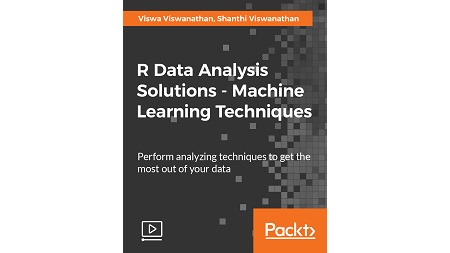
English | MP4 | AVC 1920×1080 | AAC 48KHz 2ch | 3h 12m | 705 MB
Over 40 recipes dedicated to machine learning techniques
Data analysis has recently emerged as a very important focus for a huge range of organizations and businesses. R makes detailed data analysis easier, making advanced data exploration and insight accessible to anyone interested in learning it. This video empowers you by showing you ways to use R to generate professional analysis reports. It provides examples for various important analysis and machine-learning tasks that you can try out with associated and readily available data. You will learn to carry out different tasks on the data to bring it into action.By the end of this course, you will be able to carry out different analyzing techniques, apply classification and regression, and also reduce data.
What You Will Learn
- Learn to handle missing values and duplicates
- Learn to scale and standardize values
- Reveal underlying patterns
- Learn to apply classification techniques
- Learn to apply regression techniques
- Learn to reduce data
Table of Contents
01 The Course Overview
02 Reading Data from CSV Files
03 Reading XML and JSON Data
04 Reading Data from Fixed-Width Formatted Files, R Files, and R Libraries
05 Removing and Replacing Missing Values
06 Removing Duplicate Cases
07 Rescaling a Variable
08 Normalizing or Standardizing Data in a Data Frame
09 Binning Numerical Data
10 Creating Dummies for Categorical Variables
11 Creating Standard Data Summaries
12 Extracting Subset of a Dataset
13 Splitting a Dataset
14 Creating Random Data Partitions
15 Generating Standard Plots
16 Generating Multiple Plots
17 Selecting a Graphics Device
18 Creating Plots with the Lattice and ggplot2package
19 Creating Charts that Facilitate Comparisons
20 Creating Charts that Visualize Possible Causality
21 Creating Multivariate Plots
22 Generating Error_Classification-Confusion Matrices
23 Generating ROC Charts
24 Building, Plotting, and Evaluating – Classification Trees
25 Using random Forest Models for Classification
26 Classifying Using the Support Vector Machine Approach
27 Classifying Using the Naïve Bayes Approach
28 Classifying Using the KNN Approach
29 Using Neural Networks for Classification
30 Classifying Using Linear Discriminant Function Analysis
31 Classifying Using Logistic Regression
32 Using AdaBoost to Combine Classification Tree Models
33 Computing the Root Mean Squared Error
34 Building KNN Models for Regression
35 Performing Linear Regression
36 Performing Variable Selection in Linear Regression
37 Building Regression Trees
38 Building Random Forest Models for Regression
39 Using Neural Networks for Regression
40 Performing k-Fold Cross-Validation and Leave-One-Out-Cross-Validation
41 Performing Cluster Analysis Using K-Means Clustering
42 Performing Cluster Analysis Using Hierarchical Clustering
43 Reducing Dimensionality with Principal Component Analysis
Resolve the captcha to access the links!